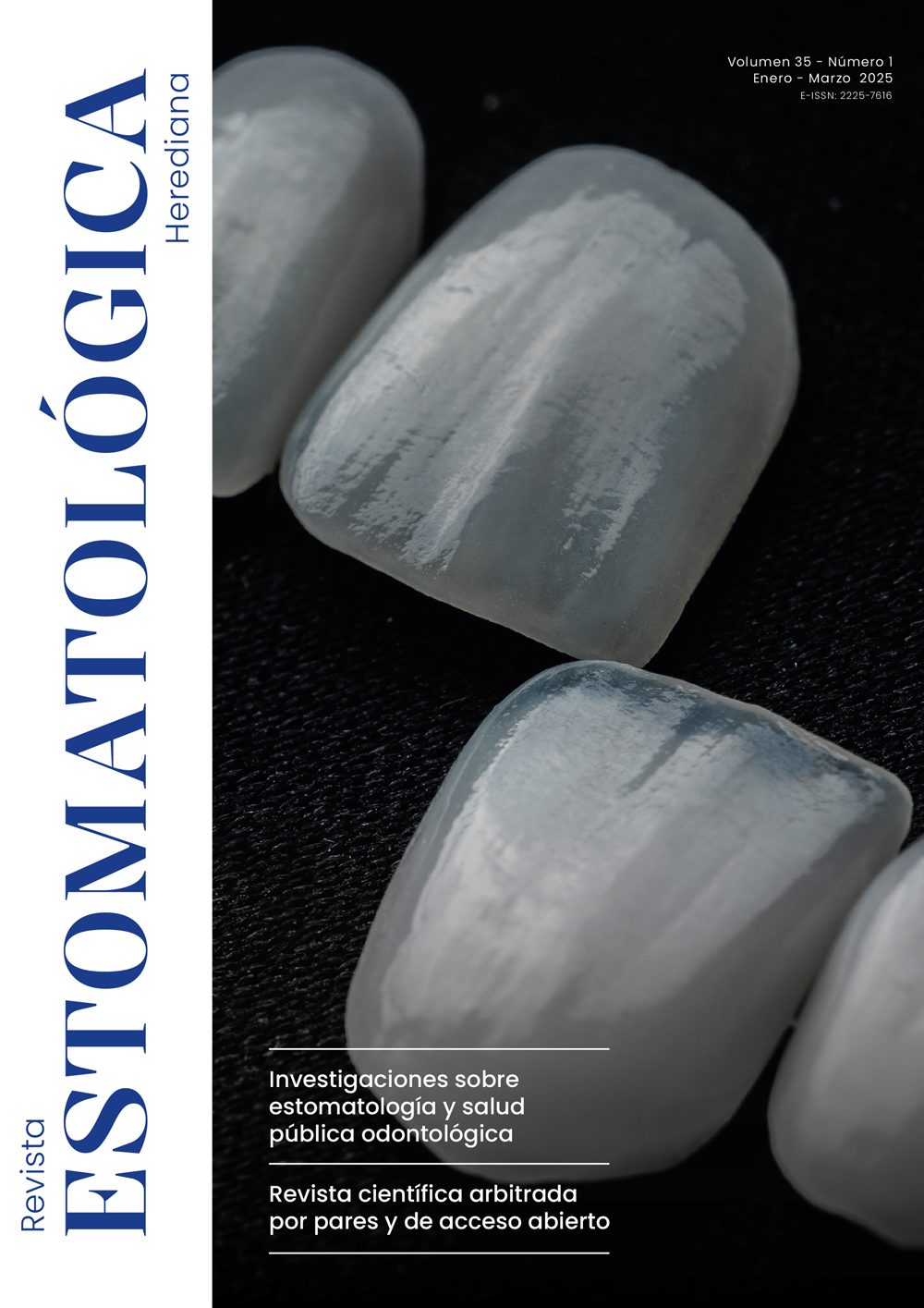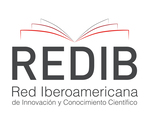Efeito antibacteriano de um cimento endodôntico experimental com a incorporação de compostos naturais (hortelã-pimenta, muña, tintura de própolis e própolis Jalk): um estudo experimental in vitro
DOI:
https://doi.org/10.20453/reh.v35i1.6321Palavras-chave:
endodontia, hortelã-pimenta, própolis, Enterococcus faecalisResumo
Objetivo: Determinar in vitro o efeito antibacteriano de um cimento endodôntico experimental com base em diferentes compostos naturais (hortelã-pimenta, muña, tintura de própolis e própolis Jalk) contra Enterococcus faecalis. Materiais e métodos: O efeito antibacteriano foi determinado contra a cepa E. faecalis (ATCC 2982), usando o método de difusão em disco. Em placas de Petri com ágar cérebro-coração (BHA), a cepa foi espalhada e os quatro compostos naturais foram colocados em discos de papel Whatman para incubação por um período de 24 horas em condições anaeróbicas. Os diâmetros dos halos de inibição foram medidos com um vernier digital. Os dados obtidos foram examinados estatisticamente pela análise de variância (ANOVA) e teste post-hoc de Tukey. Resultados: O composto de muña apresentou o maior halo de inibição (5,975 ± 0,050 mm), seguido pela hortelã-pimenta, própolis Jalk e tintura de própolis, nessa ordem. O cimento endodôntico de controle apresentou o maior halo de inibição (18,050 ± 0,451 mm), seguido pelo cimento com hortelã-pimenta (16,498 ± 0,460 mm). Conclusões: O composto de muña apresentou a maior atividade antibacteriana contra E. faecalis, enquanto a tintura de própolis apresentou a menor atividade antibacteriana. Por outro lado, os cimentos endodônticos experimentais com compostos naturais diminuíram a atividade antibacteriana em comparação com o cimento puro.
Downloads
Referências
Olczak K, Pawlicka H. Evaluation of the sealing ability of three obturation techniques using a glucose leakage test. Biomed Res Int [Internet]. 2017; 2017(1): 2704094. Disponible en: https://doi.org/10.1155/2017/2704094
Belladonna FG, Calasans-Maia MD, Alves AT, Resende RF, Souza EM, Silva EJ, et al. Biocompatibility of a self-adhesive gutta-percha-based material in subcutaneous tissue of mice. J Endod [Internet]. 2014; 40(11): 1869-1873. Disponible en: https://doi.org/10.1016/j.joen.2014.07.013
Modh H, Sequeira V, Belur A, Arun N, Dhas S, Fernandes G. Newer trends in endodontic treatment: a review. IOSR J Dent Med Sci [Internet]. 2018; 17(1): 14-16. Disponible en: https://www.iosrjournals.org/iosr-jdms/papers/Vol17-issue1/Version-10/E1701101416.pdf
Mokhtari H, Shahi S, Janani M, Reyhani MF, Mokhtari Zonouzi HR, Rahimi S, et al. Evaluation of apical leakage in root canals obturated with three different sealers in presence or absence of smear layer. Iran Endod J [Internet]. 2015; 10(2): 131-134. Disponible en: https://pmc.ncbi.nlm.nih.gov/articles/PMC4372789/
Jorgensen B, Williamson A, Chu R, Qian F. The efficacy of the WaveOne reciprocating file system versus the ProTaper retreatment system in endodontic retreatment of two different obturating techniques. J Endod [Internet]. 2017; 43(6): 1011-1013. Disponible en: https://doi.org/10.1016/j.joen.2017.01.018
Vasudeva A, Sinha DJ, Tyagi SP, Singh NN, Garg P, Upadhyay D. Disinfection of dentinal tubules with 2% Chlorhexidine gel, Calcium hydroxide and herbal intracanal medicaments against Enterococcus faecalis: an in-vitro study. Singapore Dent J [Internet]. 2017; 38: 39-44. Disponible en: https://doi.org/10.1016/j.sdj.2017.06.001
Kandaswamy D, Venkateshbabu N, Gogulnath D, Kindo AJ. Dentinal tubule disinfection with 2% chlorhexidine gel, propolis, morinda citrifolia juice, 2% povidone iodine, and calcium hydroxide. Int Endod J [Internet]. 2010; 43(5): 419-423. Disponible en: https://doi.org/10.1111/j.1365-2591.2010.01696.x
Velarde ER. Comparación del sellado apical in vitro de un cemento a base de aceite esencial de Minthostachys mollis y óxido de zinc con cemento tipo Grossman [tesis de pregrado en Internet]. Lima: Universidad Nacional Federico Villareal; 2018. Disponible en: https://hdl.handle.net/20.500.13084/3471
Gaeta C, Marruganti C, Mignosa E, Malvicini G, Verniani G, Tonini R, et al. Comparison of physico-chemical properties of zinc oxide eugenol cement and a bioceramic sealer. Aust Endod J [Internet]. 2023; 49(Suppl 1): 187-193. Disponible en: https://doi.org/10.1111/aej.12715
Rasooli I, Shayegh S, Astaneh S. The effect of Mentha spicata and Eucalyptus camaldulensis essential oils on dental biofilm. Int J Dent Hyg [Internet]. 2009; 7(3): 196-203. Disponible en: https://doi.org/10.1111/j.1601-5037.2009.00389.x
Barros A, Morais SM, Ferreira PA, Vieira ÍG, Craveiro AA, Fontenelle RO, et al. Chemical composition and functional properties of essential oils from Mentha species. Ind Crops Prod [Internet]. 2015; 76: 557-564. Disponible en: https://doi.org/10.1016/j.indcrop.2015.07.004
Marín-Bauza GA, Silva-Sousa YT, Cunha SA, Rached-Junior FJ, Bonetti-Filho I, Sousa-Neto MD, et al. Physicochemical properties of endodontic sealers of different bases. J Appl Oral Sci [Internet]. 2012; 20(4): 455-461. Disponible en: https://doi.org/10.1590/s1678-77572012000400011
Sundqvist G, Figdor D, Persson S, Sjögren U. Microbiologic analysis of teeth with failed endodontic treatment and the outcome of conservative re-treatment. Oral Surg Oral Med Oral Pathol Oral Radiol Endod [Internet]. 1998; 85(1): 86-93. Disponible en: https://doi.org/10.1016/S1079-2104(98)90404-8
Torrenegra-Alarcón M, Granados-Conde C, Durán-Lengua M, León-Méndez G, Yáñez-Rueda X, Martínez C, et al. Composición química y actividad antibacteriana del aceite esencial de Minthostachys mollis. Orinoquia [Internet]. 2016; 20(1): 69-74. Disponible en: https://doi.org/10.22579/20112629.329
Kitagawa H, Kitagawa R, Tsuboi R, Hirose N, Thongthai P, Sakai H, et al. Development of endodontic sealers containing antimicrobial polimer particles with long term antibacterial effects. Dent Mater [Internet]. 2021; 37(8): 1248-1259. Disponible en: https://doi.org/10.1016/j.dental.2021.04.008
Cecchini ME, Paoloni C, Campra N, Picco N, Grosso MC, Soriano Perez ML, et al. Nanoemulsion of Minthostachys verticillate essential oil. In-vitro evaluation of its antibacterial activity. Heliyon [Internet]. 2021; 7(1): e05896. Disponible en: https://doi.org/10.1016/j.heliyon.2021.e05896
Shayegh S, Rasooli I, Taghizadeh M, Astaneh SD. Phytotherapeutic inhibition of supragingival dental plaque. Nat Prod Res [Internet]. 2008; 22(5): 428-439. Disponible en: https://doi.org/10.1080/14786410701591739
Dalmia S, Gaikwad A, Samuel R, Aher G, Gulve M, Kolhe S. Antimicrobial efficacy of different endodontic sealers against Enterococcus faecalis: an in vitro study. J Int Soc Prevent Community Dent [Internet]. 2018; 8(2): 104-109. Disponible en: https://doi.org/10.4103/jispcd.jispcd_29_18
Munitić MS, Budimir A, Jakovljevic S, Anic I, Bago I. Short-term antibacterial efficacy of three bioceramic root canal sealers against Enterococcus faecalis biofilms. Acta Stomatol Croat [Internet]. 2020; 54(1): 3-9. Disponible en: https://doi.org/10.15644/asc54/1/1
Arora S, Mir S, Gautam A, Batra R, Soni S, Lata K. Evaluation of antimicrobial efficacy of root canal sealers against Enterococcus faecalis: a comparative study. J Contemp Dent Prac [Internet]. 2018; 19(6): 680-683. Disponible en: https://doi.org/10.5005/jp-journals-10024-2319
Peciuliene V, Balciuniene I, Eriksen HM, Haapasalo M. Isolation of Enterococcus faecalis in previously root-filled canals in a Lithuanian population. J Endod [Internet]. 2000; 26(10): 593-595. Disponible en: https://doi.org/10.1097/00004770-200010000-00004
Mamadalieva NZ, Hussain H, Xiao J. Recent advances in genus Mentha: phytochemistry, antimicrobial effects, and food applications. Food Front [Internet]. 2020; 1(4): 435-458. Disponible en: https://doi.org/10.1002/fft2.53
Farré R, Frasquet I, Sánchez A. Propolis and human health. Ars Pharmaceutica [Internet]. 2004; 45(1): 21-43. Disponible en: https://revistaseug.ugr.es/index.php/ars/article/view/5105
Torres-Mantilla JD. Comparación del efecto antibacteriano de un extracto etanólico de propóleo a dos concentraciones y del paramonoclorofenol alcanforado frente a Enterococcus faecalis y Fusobacterium nucleatum. Rev Cient Odontol [Internet]. 2019; 7(1): 53-65. Disponible en: https://doi.org/10.21142/2523-2754-0701-2019-53-65
Delgado ML, Andrade JÁ, Ramírez CA. Caracterización fisicoquímica de propóleos colectados en el Bosque La Primavera Zapopan, Jalisco. Rev Mex Cienc For [Internet]. 2015; 6(28): 74-87. Disponible en: https://cienciasforestales.inifap.gob.mx/index.php/forestales/article/view/270
Cavalcante RB, Moura AJ, Araújo MA, Moreira-Araújo RS. Bioacessibility of phenolic compounds and antioxidant capacity in organic peppermint leaves. Rev Chil Nutr [Internet]. 2021; 48(2): 157-162. Disponible en: http://dx.doi.org/10.4067/S0717-75182021000200157
Ferreira RO, Carvalho Junior AR, Silva TMG, Castro RN, Silva TMS, Carvalho MG. Distribution of metabolites in galled and non-galled leaves of Clusia lanceolata and its antioxidant activity. Rev Bras Farmacogn [Internet]. 2014; 24(6): 617-625. Disponible en: https://doi.org/10.1016/j.bjp.2014.11.005
Publicado
Como Citar
Edição
Seção
Licença
Copyright (c) 2025 Erwin Duilio Pickling Gonzales-Posada, Karina Huamán Mujica, John Alexis Dominguez

Este trabalho está licenciado sob uma licença Creative Commons Attribution 4.0 International License.
Os autores mantêm os direitos autorais e cedem à revista o direito de primeira publicação, sendo o trabalho registrado com a Licença Creative Commons, que permite que terceiros utilizem o que é publicado desde que mencionem a autoria do trabalho, e ao primeiro publicação nesta revista.























